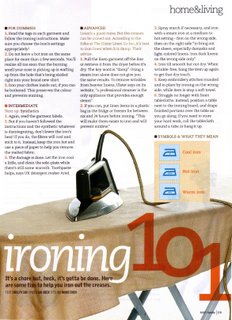How to Organize Your Wardrobe
Own a closet full of clothes but got nothing to wear? It's about time you give yourself a wardrobe overhaul. Set aside one weekend, and follow these advices from professional stylists to organize and put together a wardrobe that screams effortlessly effective.
1. Separate your clothing according to usage. Your wardrobe may be bulging with loads of items, but how many of those have actually been worn within the past year, if at all? Clothes and accessories that are hardly ever worn should be tossed out to clear the space.
The key is to pare down your wardrobe to the pieces that really work for you - keep only the stuff you regularly use within easy view (and of course, reach). Otherwise, they'll be hidden under the piles and you'll soon forget that you have them in the first place.
Start by sorting all your clothing into 3 piles:
* Items that are regularly used and which you feel comfortable in.
* Garments that you have a sentimental or emotional attachment to.
* Clothes that need mending, don't fit, make you look fat or, for some other reasons, haven't been worn for more than a year.
2. Hang your clothes by categories. Arrange your regularly used items in the front of your wardrobe so that they are easily accessible. Sort them in order and categorize them.
Professional stylists suggest hanging your items by style then by color. For instance, your hanging sequence may be like this:
# Tops from tube tops to sleeveless to short sleeves to long sleeves.
# Skirts from short to mid-length to long.
# Pants from short to long.
# Jackets from casual to work to dressy.
Then arrange by color within these sub-groups.
3. Storing clothes that shouldn't be hung. For space efficiency and fabric care reasons, some clothes are best stored away folded.
Foldable Clothes. Keep foldable clothes like T-shirts, jeans and knits in shelves. As well as saving wardrobe space, folding - instead of hanging - delicate fabrics such as knits will keep them from stretching out of shape on the hanger. And remember, keep the pile minimal - large piles tend to collapse very easily. If shelf space is a problem, you can easily get additional mini drawers and stackable boxes from DIY stores at affordable prices.
Sentimental Pieces. For those precious or expensive items that you rarely wear but want to keep, fold them away in drawers with chemical desiccants such as calcium chloride to absorb moisture and prevent mold and mildew. Take care not to let the desiccant touch the garments.
4. Deciding which to toss out. From the pile of 'unwearable' clothes, you can judge whether to keep or to throw:
Simple Mending. You know what to do with clothes that have fallen hems, missing buttons, etc. Spend some time sewing them back and you'll have pieces that feel as good as new.
Ill-fitting Clothes. Clothes that no longer fit, or never have. Pants that can't zip shut unless you lose some weight. Bargain pieces that aren't flattering at all. Just toss these or give them away to your friends or family members.
5. Extra storage ideas for your accessories. Now that you've successfully sorted out your clothing, here are more tips on how to keep your accessories organized.
Belts. Get a men's tie rack and hang your belts on it.
Handbags. Stuff the bags with smaller bags or crushed magazine pages (save trees - don't use brand new paper for this) to retain their shape. Store them in a big see-through plastic zipper bag so that the dust won't get on them.
Hats. Install hooks on the inside of closet doors to hang your hats.
Scarves, stockings, and other accessories. Keep each category in a clear plastic stackable box, so you can see the items from the outside.
Shoes. Store your shoes in a shoe organizer. Or keep them in their original shoe box, to store them in neat stacks. Write a description of the shoes with a marker pen on each box so you can easily find the right pair without needing to rummage for it. You can even stick a photo of the shoe on the box - it may sound extreme but stylists reveal that some hard-core shoe fanatics actually do this!
Copyright © ShoppingLifestyle®
